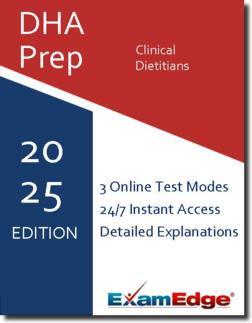DHA Clinical Dietitians (DHA-Diet) Practice Tests & Test Prep - Topics
Based on 25 Reviews
- Real Exam Simulation: Timed questions and matching content build comfort for your DHA Clinical Dietitians test day.
- Instant, 24/7 Access: Web-based DHA Clinical Dietitians practice exams with no software needed.
- Clear Explanations: Step-by-step answers and explanations for your DHA exam to strengthen understanding.
- Boosted Confidence: Reduces anxiety and improves test-taking skills to ace your DHA Clinical Dietitians (NUTRO).

Understanding the exact breakdown of the DHA Clinical Dietitians test will help you know what to expect and how to most effectively prepare. The DHA Clinical Dietitians has 100 multiple-choice questions The exam will be broken down into the sections below:
| DHA Clinical Dietitians Exam Blueprint | ||
|---|---|---|
| Domain Name | ||
| Fundamental of Dietetics, Food Management and Services | ||
| Obesity | ||
| Cardiovascular Diseases | ||
| Diabetes Mellitus | ||
| Renal Diseases | ||
| Liver Diseases | ||
| Gastro-Intestinal Diseases | ||
| Metabolic Disorders | ||
| Inflammatory Diseases and Cancer | ||
| Nutrition Support | ||
| Community Nutrition | ||
| Nutrition Through Life Cycle |


